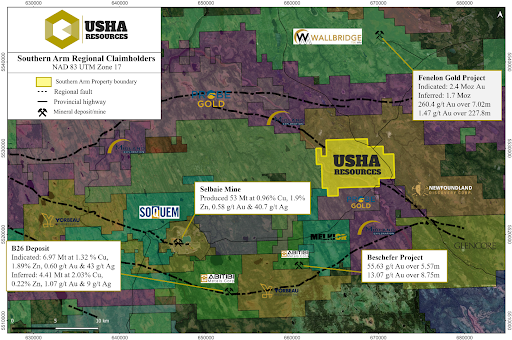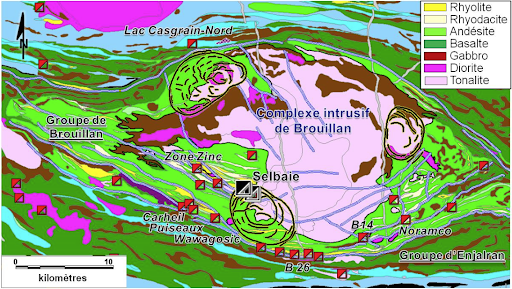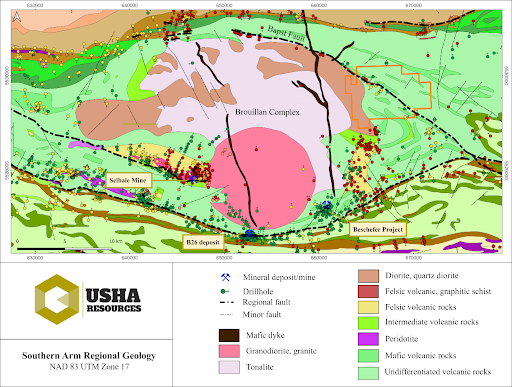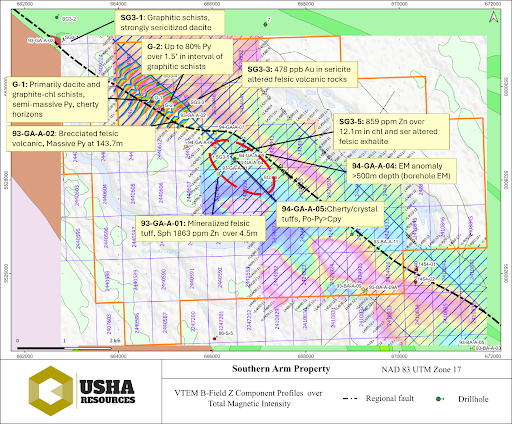Vancouver, British Columbia / May 12,, 2025 – Usha Resources Ltd. (“Usha”, “USHA” or the “Company”) (TSXV: USHA) (OTCQB: USHAF) (FSE: JO0), a North American mineral acquisition and exploration company, is pleased to announce that,...
Read MoreThe Southern Arm property comprises ~4,200 hectares of prospective ground in the metal-rich northwest Abitibi subprovince. The project is strategically situated in the calc-alkaline volcanic rocks of the Brouillan-Fenelon assemblage, which are host to the nearby Selbaie Mine and B26 polymetallic VMS deposits (Fig. 1) that have a long history of copper, zinc, silver and gold production. Roads in the area were developed to allow access to the local mining operations, and permit access to the Southern Arm property as well. The property was optioned from Abitibi Metals Corp. following their success at the proximal B26 and Beschefer projects, which are located just 16 km and 9 km from the Southern Arm Property, respectively. The Abitibi Metals team plans to help guide Usha’s exploration on the property as the Company progresses the high priority polymetallic VMS exploration targets identified on the Property.

Southern Arm VMS Favourability
The Southern Arm property contains many geologic features consistent with VMS mineralizing systems. Faure (2011) placed the rocks of the Southern Arm property into the context of a volcanic environment and highlighted the potential for a polymetallic VMS system on the eastern side of the Brouillan intrusive complex (Fig. 1), by satisfying the three principal criteria for VMS formation in the Abitibi, as outlined by Lamothe et al., (2005).

Figure 1: Updated interpretation of the synvolcanic Brouillan Complex. Synvolcanic faults are shown in blue, and inferred calderas are indicated with black, concentric structures. From Faure (2011).
Lithologic Controls
A hiatus or pause in volcanism is required to allow for mineralizing fluid circulation. These pauses are often represented by a mafic-felsic volcanic rock contact, interflow sedimentary rocks (exhalite, chert, iron formation), proximity to a volcanic centre, or a variation in felsic volcanic lithogeochemistry. The Southern Arm property hosts cherty and exhalite horizons, which have undergone sericite and chlorite alteration. Circular geophysical features along the easternmost extent of the Brouillan Pluton have been interpreted to represent synvolcanic calderas, indicating a volcanic centre on the eastern margin of the Brouillan Complex (Fig. 2). Faure (2011) describes synvolcanic faults, such as the Bapst Fault on the Southern Arm Property (Fig. 2), as high priority exploration targets.

Figure 2: Regional geology of the Southern Arm Property Heat Source
A proximal source of heat (e.g. subvolcanic intermediate or felsic intrusions, shallow mafic or ultramafic sill or high-temperature rhyolites) drives circulation of the mineralizing fluids (Lamothe et al., 2005). The synvolcanic Brouillan Pluton occurs on the western side of the Southern Arm property and is also associated with the nearby Selbaie Mine and B26 deposit (Fig. 2). Heat from this intrusion was presumably associated with these deposits and may have also driven hydrothermal fluid circulation on the Southern Arm Property.
Hydrothermal Activity
Alteration (chlorite, white mica and aluminous minerals) and/or sulphide minerals (Cpy, Sph, Py) localized by primary volcanic structures indicate that fluids were circulating during volcanism, and nearby base metal occurrences indicate a favourable environment for metal deposition. An abundance of nearby base and precious metals deposits indicate, at the high level, that primary volcanic structures of the Brouillan Complex were conducive to mineralizing processes. At the Southern Arm property industry drill logs report sericite and chlorite alteration associated with elevated Zn and Cu values, (up to 859 ppm Zn and 224 ppm Cu over 12.1m; Fig. 3) along the synvolcanic Bapst Fault, indicating fluid activity. Abundant glacial overburden overlies these rocks, so they are only documented in industry reported drill holes and they have not been the target of an extensive subsurface exploration program.
Exploration Potential
The Southern Arm property hosts a 7.3 km stretch of the synvolcanic Bapst Fault, which has not seen significant exploration due to the extensive till cover. An EM anomaly is associated with this trend in the northwest corner of the Property (Fig. 3; Geotech VTEM, 2017). The four historic drill logs targeting this anomaly intersected intervals of graphite schists hosting intercalation of felsic volcanic rocks and massive pyrite; assays returned up to 478 ppb Au. Southeast of this anomaly, in the central area of the Property, the historic drill logs report minimal graphite horizons (red circle; Fig. 3). Felsic volcanic rocks here are chlorite and sericite altered and return anomalous Cu and Zn values. It is also here that exhalite, chert, and mineralized felsic tuffs are reported. Usha plans to refine targets within this area using ground-based geophysics so that they can be included in the Company’s maiden diamond drill campaign at the Southern Arm Property.

Figure 3: Southern Arm Property VTEM B-Field Z-Component Profiles; Time Gates 0.220 – 7.036ms over Total Magnetic Intensity
Why Copper?
The global push towards clean electrical energy, coupled with nationalist movements by countries looking to maintain domestic resources, is driving an unprecedented surge in copper demand. Usha Resources is a Canadian-based junior exploration company that is dedicated to advancing critical metal production in Canada and has capitalized on the increasing demand of copper, as well as diversified its portfolio, by adding the Southern Arm asset to its holdings. Copper is currently deemed one of the most sought-after critical metals, as several rising geopolitical and market trends have helped to catalyze an emerging supercycle in the copper market. However, recent advancements in copper supply have been limited due to a several-year period of consolidation in copper prices and copper producers preferring mergers and acquisitions of assets rather than advancing early-stage exploration targets. The Southern Arm property presents a rare opportunity for advancing an asset from the ground level, within the established Abitibi mining district of mining friendly Quebec.
Vancouver, British Columbia / May 12,, 2025 – Usha Resources Ltd. (“Usha”, “USHA” or the “Company”) (TSXV: USHA) (OTCQB: USHAF) (FSE: JO0), a North American mineral acquisition and exploration company, is pleased to announce that,...
Read MoreUsha Resources Executes Letter of Intent To Sell Up to 90% of the Jackpot Lake Lithium Brine Project for Total Consideration of up to US$26,025,000 Vancouver, British Columbia / May 17, 2024 – Usha Resources...
Read MoreHighlights: Vancouver, British Columbia / September 6, 2023 – Usha Resources Ltd. (“USHA” or the “Company”) (TSXV: USHA) (OTCQB: USHAF) (FSE: JO0), a North American lithium exploration company, is pleased to announce that following a...
Read More